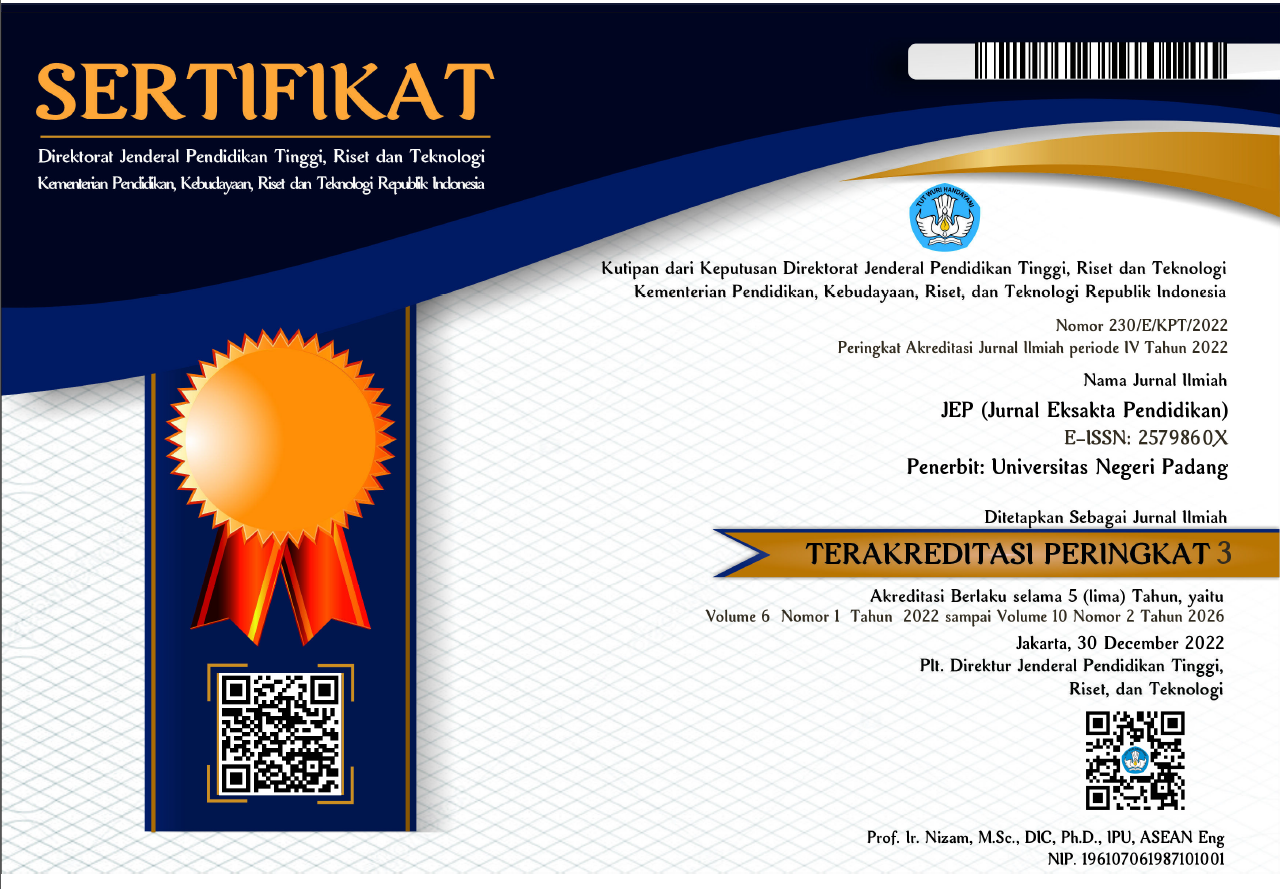Development of Mersics.com as an E-diagnostic Assessment with Rasch Model in Prerequisite Material for the Kinematics Chapter
Abstract
E-diagnostic Assessment is a diagnostic test instrument based on the Merscs.com website, which is used to determine students' initial level of understanding before carrying out physics learning. This research aims to determine the validity and reliability of the development of Mersics.com as an e-diagnostic assessment of the prerequisite material for the kinematics chapter. The limited trial subjects in this research were 75 class XI MIA students. Validity analysis uses the Item Response Theory (IRT) approach with one Logistic Parameter (PL), the difficulty level parameter, better known as the Rasch Model. The research results showed that 56 questions were declared valid by experts using Content Validity Ratio (CVR > 0) analysis. Meanwhile, the results of the analysis based on the Rasch Model showed 20 valid questions in the Understanding of Motion sub-chapter, nine valid questions and one invalid question item in the GLB and GLBB sub-chapters, ten valid questions in the Parabolic Motion sub-chapter, nine valid questions and one the question item is invalid and in the Circular Motion sub-chapter. The reliability of the questions as a whole is declared reliable. It can be concluded that this E-diagnostic Assessment is suitable for use in physics learning.
Downloads
References
Adams, R. J., & Khoo, S. T. (1996). Quest: The interactive test analysis system version 2.1. Melbourne: ACER.
Aida, N., Kusaeri, K., & Hamdani, S. (2017). Karakteristik Instrumen Penilaian Hasil Belajar Matematika Ranah Kognitif yang Dikembangkan Mengacu pada Model PISA. Suska Journal of Mathematics Education, 3(2), 130. https://doi.org/10.24014/sjme.v3i2.3897
Angraeni, D. N., Suherman, A., & Guntara, Y. (2020). Aplikasi Rasch Model: Pengembangan Fluids Assessment (Fass) Berdasarkan Taxonomy of Introductory Physics Problems (TIPP). Jurnal Penelitian Pembelajaran Fisika, 11(2), 135–143. https://doi.org/10.26877/jp2f.v11i2.5903
Bond T.G. dan Fox C.M. (2007). Applying the Rasch Model Fundamental Measurement in the Human Science. 2nd Ed, New Jersey: Lawrence Erbaum Associates, 11-14.
Boone, W.J., Staver, J.R., & Yale, M.S. (2014). Rasch Analysis in the Human Sciences. Dordrecht: Springer.
Borg, W. R., & Gall, M. D. (1989). Educational Research: An Introduction, Fifthy Edition. New York: Longman.
Dewi Cahyono, S. (2022). Melalui Model Teaching at Right Level (TARL) Metode Pemberian Tugas untuk Meningkatkan Motivasi dan Hasil Belajar Peserta Didik. Jurnal Pendidikan Tambusai, 6(2), 12407–12418.
Fauzan, F., Ansori, R. A. M., Dannur, M., Pratama, A., & Hairit, A. (2023). The Implementation of the Merdeka Curriculum (Independent Curriculum) in Strengthening Students’ Character in Indonesia. Aqlamuna: Journal of Educational Studies, 1(1), 136–155. https://doi.org/10.58223/aqlamuna.v1i1.237
Fitriatun, A., & Sukanti. (2016). Analisis Validitas, Reliabilitas, Dan Butir Soal Latihan Ujian Nasional Ekonomi Akuntansi Di Man MAN Maguwaharjo. Jurnal Kajian Pendidikan Akuntansi Indonesia, (3), 1–11.
Jannah, R. & I. R. (2020). Pengembangan E-Diagnostic Four Tier Test Untuk Mengidentifikasi Miskonsepsi Peserta Didik. Natural Science: Jurnal Penelitian Bidang IPA Dan Pendidikan IPA, 6(2), 151–160.
Julianda, R., Saminan, & Halim, A. (2022). Analisis Miskonsepsi Siswa dengan Two Tier Diagnostic Test pada Materi Gerak Lurus di SMA Negeri 3 Banda Aceh. Journal of Technology and Literacy in Education, 1(1), 14–20.
Koimah, N., & Muchtar, Z. (2022). Pengembangan tes diagnostik berbasis web pada materi konsep redoks. Jurnal Ilmiah Pendidikan, 1(6), 636–644.
Kurniawan, U., Andriyani, K. D. K. (2018). Analisis Soal Pilihan Ganda dengan Rasch Model. Jurnal Statistika, 6(1), 1-6. https://doi.org/10.26714/jsunimus.6.1.2018.%25p.
Maulana, S., Rusilowati, A., Nugroho, S. E., & Susilaningsih, E. (2023). Implementasi Rasch Model dalam Pengembangan Instrumen Tes Diagnostik. Prosiding Seminar Nasional Pascasarjana (PROSNAMPAS), 6(1), 748–757. https://proceeding.unnes.ac.id/index.php/snpasca/article/view/2214
McDermott dkk, L. C. (2017). Development and application of afour-tier test to assess pre-service physics teachers’misconceptions about geometrical optics.
Misbach, I. H., & Sumintono, B. (2014). Pengembangan dan Validasi Instrumen "Persepsi Siswa terhadap Karakter Moral Guru" di Indonesia dengan Model Rach.
Mubarokah, S. (2022). Tantangan Implementasi Pendekatan TaRL (Teaching at the Right Level) dalam Literasi Dasar yang Inklusif di Madrasah Ibtida’iyah Lombok Timur. BADA’A: Jurnal Ilmiah Pendidikan, 4(1), 165–179. https://doi.org/10.37216/badaa.v4i1.582
Nurhayati, N., Alsagaf, S. L. H., & Wahyudi, W. (2019). Pengembangan Tes Diagnostik Three-Tier Multiple Choice Untuk Mengukur Konsepsi Fisika Siswa SMA. Jurnal Pendidikan, 4(2), 47–54.
Pujayanto, P., Budiharti, R., Adhitama, E., Nuraini, A., & Putri, H. V. (2018). The development of a web- based assessment system to identify students’ misconception automatically on linear kinematics with a four-tier instrument test. Journal Physics Education, 53(4).1-8.
Purnomo. (2015). Dasar-Dasar dan Perancangan Evaluasi Pembelajaran. Fakultas Keguruan dan Ilmu Pendidikan: Universitas Lampung.
Purwanto. (2013). Evaluasi Hasil Belajar. Yogyakarta: Pustaka Pelajar.
Rohmah, Z.-, Handika, J.-, & Huriawati, F.-. (2019). E-Diagnostic Test untuk Mengungkap Miskonsepsi Kinematika. SPEKTRA : Jurnal Kajian Pendidikan Sains, 5(1), 22. https://doi.org/10.32699/spektra.v5i1.86
Rokhman, O., Ningsih, A. N., Augia, T., Dahlan, H., Rosyada, Amrina, Putri, Dini Arista, Fajar, N. A., Yuniarti, E., Vinnata, N. N., Pujiwidodo, D., Ju, J., Wei, S. J., Savira, F., Suharsono, Y., Aragão, R., Linsi, L., Editor, B., Reeger, U., Sievers, W., Michalopoulou, C., Mimis, A., … Devita, M. (2020). Jurnal Berkala Epidemiologi, 5(1), 90–96. https://core.ac.uk/download/pdf/235085111.pdf%0Awebsite:http://www.kemkes.go.id%0Ahttp://www.yankes.kemkes.go.id/assets/downloads/PMK No. 57 Tahun 2013 tentang PTRM.pdf%0Ahttps://www.kemenpppa.go.id/lib/uploads/list/15242-profil-anak-indonesia_-2019.pdf%0Aht
Setyo Adji Wahyudi, Mohammad Siddik, & Erna Suhartini. (2023). Analisis Pembelajaran IPAS dengan Penerapan Pendekatan Pembelajaran Berdiferensiasi dalam Kurikulum Merdeka. Jurnal Pendidikan Mipa, 13(4), 1105–1113. https://doi.org/10.37630/jpm.v13i4.1296
Sugiyono. (2012). Memahami Penelitian Kualitatif. Bandung: ALFABETA.
Sumintono, B dan Widhiarso, W. (2015). Aplikasi Pemodelan Rasch pada Assessment Pendidikan. Cimahi: Trim Komunikata Publishing House.
Suseno, E. dan Susongko, P. (2021). Mengukur Validitas Tes. Edisi ke-1. Pemeral Edukreatif. Jawa Timur.
Suyoso, S., Istiyono, E., & Subroto, S. (2017). Pengembangan Instrumen Asesmen Pengetahuan Fisika Berbasis Komputer Untuk Meningkatkan Kesiapan Peserta Didik Dalam Menghadapi Ujian Nasional Berbasis Komputer. Jurnal Pendidikan Matematika Dan Sains, 5(1), 89–97. https://doi.org/10.21831/jpms.v5i1.12461
Wahyuni, N., Bhakti, Y. B., Mutakin, T. Z., & Astuti, I. A. D. (2021). The Development of Four-Tier Diagnostic Test Instrument to Identify the Learners’ Misconception on Circular Motions. Impulse: Journal of Research and Innovation in Physics Education, 1(1), 24–31. https://doi.org/10.14421/impulse.2021.11-03
Widhiarso, W. (2010). Prosedur Pengujian Validitas Isi melalui Indeks Rasio Validitas ISi (CVR). Yogyakarta: Fakultas Psikologi UGM.
Copyright (c) 2024 Agun Gunawan, Yudi Guntara, Asep Saefullah

This work is licensed under a Creative Commons Attribution 4.0 International License.

This work is licensed under a Creative Commons Attribution 4.0 International License.




_(2579-860X).png)
_(2614-1221)1.png)




